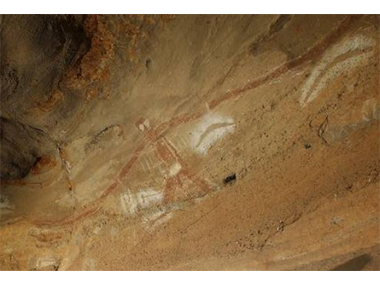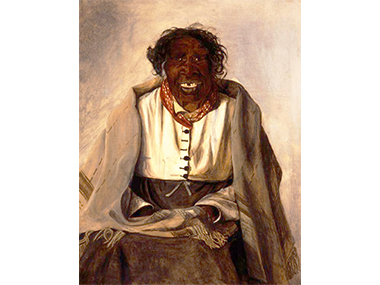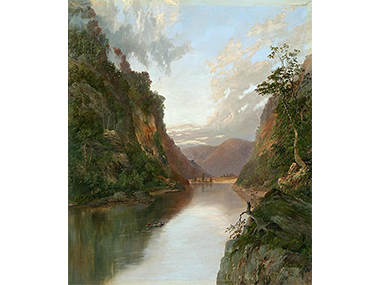DYARUBBIN

The Eagle-Being on the walls at the Milbrodale shelter - possibly the work of Biraban
Jeremy Eccles | 21.12.20
Author: Jeremy Eccles
News source: Review
That's a word you're going to hear a lot more of in the 2020s, for it's the proper name for the river system that surrounds Sydney – the oddly-named Hawkesbury/Nepean. Why did early colonists think there were two rivers when clearly we can now see them as a single river that just happens to take a right angle bend at one point?. Were they just looking around for as many things as possible to name after distant English nobs? For a perfectly good name existed - Dyarubbin - and was a vital part of pre-existing Sydney life.
Indeed, so vital was it that there are actually 170 specific names recorded for various features of Dyarubbin – not just salt and freshwater features, but bankside factors, ceremonial and spiritual places, plants and creatures, all recorded in the Rev. John McGarvie's handwritten document from 1829, but lost in the State Library's incredible depths until 2017, when historian Grace Karskens happened upon it while researching for her huge and wonderful book, 'People of the River', published in September.
And the find has lead on to 'The Real Secret River' project to connect those Darug, Darkinjung and Gandangara names to places on the ground and in the waters, linking them to traditional knowledge, history and ecology so that we all may share in the reality of Dyarubbin.
Though perhaps the first battle is to establish a consistent spelling for the word – I've now spotted three different versions!
Anyone familiar with Kate Grenville's 'Secret River' books (play and TV series) will naturally wonder whether they need to take this story any further. But Karskens is adamant that the balance of power presented in Grenville's work represented the 'doomed' Aborigines as passive victims, while the essence of her 670 page study is that not only did the locals fight back (as we saw in 'The Sydney Wars') but that there was much cross-cultural contact - “diplomacy, negotiation, conciliation, cooperation, friendship, intimate relations and lively exchanges of things, words and ideas”. In many ways, in fact, the Dyarubbin people are still there.
Grenville did, however, get one thing right. The importance of the native long yams that were immediately displaced by colonial corn in the rich alluvial soils along the river. For Dyarubbin is actually the Gundangara name for the long yam – as revealed in the word lists at Karskens' book's end.
Another important factor from Grenville: the reality – as distinct from the colonial meta-story – was that the non-Indigenous people who took up land on Dyarubbin were mainly a heterogeneous collection of emancipists who soon began to live lives very like the previous inhabitants – huts of canvas or bark, “shelter that was easily replaced if washed away or burned down”, paddling bark canoes up and down the river, hunting and fishing in the forests and “using fire for cooking, warmth and sociability, to keep the forests open and to ward off darkness and devils”.
On the other side, full-blood woman, Nah Doongh (or Black Nellie) was probably in her 90s in Penrith when she was befriended by writer and painter Sara Shand, sharing childhood memories and a song about the four generations of Macarthurs of Camden Park (where she and her husband worked) who'd accumulated more and more land as the family bred and prospered. “All the land belong to Mr McCarthy”, she repeated bitterly. It was the colonial trope, Karskens argues, that families like the Macarthurs were heroic, while Black families were violent, profligate and the women lascivious. Nah Doongh denied that; and Governor Macquarie's Native Institution, established to civilise her people, failed because Aboriginal families wanted to maintain their culture, not be assimilated.
And what culture Karkens records – huge male and female ancestral beings engraved into rock platforms or painted on the walls of the Maroota shelter; the 11metre Eel-Being (Gurangatty) engraved at Cattai with a right-angle bend to its body which surely suggests a Rainbow Serpent from the north in the act of creating Dyarubbin; the painted Eagle-Being at Milbrodale, with large white earnest eyes flying straight at viewers, possibly the work of one Biraban who “had a vision of Jehovah” in the 1830s; and tales of the Baiame Waganna in 1833, a spiritual revival (as would happen later in the Kimberley as culture was threatened there) attempting to find meaning in a “ruptured world” through the old god Baiame.
Karskens also gets on the cultural record the 'cobble' or simple stone axe that was found on the river at Castlereagh and proved to have a 50,000 year history – which, serendipitously, has recently found a permanent home in the foyer of the new Chau Chak Wing Museum in Sydney University.
Apart from Dyarubbin, the name to discover in this mighty book is James Matra. This son of a Corsican/American doctor somehow joined the British navy and sailed with Cook on the Endeavour in 1770, remaining friends with Joseph Banks. With his American background, perhaps he foresaw the future Australia as a replacement colony and prison where ex-convicts might be turned into valuable citizens: “Give them a few acres of ground in absolute property, with what assistance they may want to till them; they cannot fly from the Country, they have no temptations to Theft; and they must work or starve” was his advice to the government in 1784. A popular song in Britain predicted that, uniquely, they would “Become a new people at Botany Bay”. For this had not been the pattern in Canada, the US and the Caribbean.
Mr Matra surely deserves greater recognition than giving his name to suburban Matraville!
For Matra's plan sought to create a 'common' society in New South Wales. Sadly, it only lasted for a time, as the distinctly more capitalist Bigge Report in the 1820s undermined its potential by proposing a new 'improved' class of settler be encouraged to come with freedom and money rather than crime and need, soon to become squatters, 'pioneers' and, frequently, the perpetrators of First Nations massacres.
Despite which – and Karskens is determined that the early 'Battle' of Richmond Hill was actually a massacre, since not a single soldier was injured or killed – the poets of the Dyarubbin people may be said to have kept the faith alive through invasion, massacre, smallpox, land theft and assimilation. For Wulatji, a peripatetic philosopher and poet recorded by the Rev Lancelot Thelkeld in the 1840s, composed and recited this song – which was translated by Jim Wafer in 2017:
Ours is the place where the mountains cohabit with the heights
The eaglehawks and wallabies are happy.
The kangaroos dance in the grass to smooth it down
Ours is the head of the fish in the water.
The sweet honeycomb, the nectar inside the wooden bowl
Ours are the splendid and beautiful young women.
A snip at $40 from Allen & Unwin
Share this:
»  del.icio.us
»
del.icio.us
»  Digg it
»
Digg it
»  reddit
»
reddit
»  Google
»
Google
»  StumbleUpon
»
StumbleUpon
»  Technorati
»
Technorati
»  Facebook
Facebook
Contact Details

The nongenarian Nah Doongh, painted by the recorder of her bitter song, Sara Shand

How peaceful once was the Dyarubbin - as captured in 1881 by William Piguenit at the Nepean Gorge.
Further Research
Artists: Biraban
News Tags: Bigge Report | Chau Chak Wing Museum | Dyarubbin | emancipists | Grace Karskens | Hawkesbury/Nepean River | James Matra | Jeremy Eccles | Kate Grenville | Macarthur family
News Archive
- 04.01.21 | Appreciating Mparntwe
- 21.12.20 | DYARUBBIN
- 14.12.20 | FOUR DAYS TO GO
- 09.12.20 | Museological Sydney
- 08.12.20 | Influential Aussies
- 03.12.20 | The Kelton Collection Heads to Switzerland
- 02.12.20 | Getting Back into the Habit in Sydney
- 27.11.20 | Putting the Cart Before the Horse?
- 25.11.20 | VICTORIA OPENS!
- 17.11.20 | Aboriginal Art Storms Online
- 10.11.20 | Michael Nelson Jagamara AM 1946 – 2020
- 10.11.20 | 'Nilimurra Dhuwal: Here We Are' by Guynbi Ganambarr
- 06.11.20 | GORDON BENNETT SOLO IN QUEENSLAND
- 30.10.20 | Cursed!
- 28.10.20 | The 'Seven Sisters' Heading for England
Advertising

